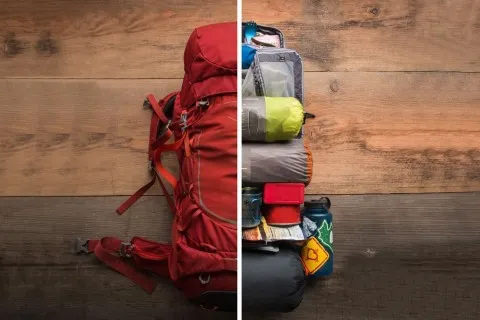Comprehensive Guide to Packing and Organizing a Hiking Backpack
Choosing the Right Backpack for Hiking
Selecting the right backpack is one of the most crucial steps in preparing for a successful hiking trip. A comprehensive guide to packing and setting up your hiking backpack requires attention to various factors including the backpack’s volume, your body’s carrying capacity, and ergonomic features. The backpack should align with the hiker’s body and distribute weight evenly. Additionally, the type of activities planned, the duration of the trip, and the expected weather conditions are essential considerations when choosing the perfect backpack. Reputable brands like Iran Charter offer a variety of high-standard backpacks, catering to both professional and amateur hikers alike.
Ergonomic Features of Hiking Backpacks
The ergonomic features of hiking backpacks directly affect your comfort and efficiency during the hike. One of the most important features is the adjustable shoulder straps, which should be set to avoid excess pressure on the shoulders and ensure the backpack fits snugly onto your back. A sturdy hip belt is another ergonomic feature, which transfers the backpack’s weight to the hips, reducing shoulder strain. Proper ventilation systems are crucial to allow air circulation behind the backpack, preventing excessive sweating. Furthermore, the backpack should have a back panel that naturally fits the curves of your body for unrestricted movement.
How to Organize Gear in a Hiking Backpack
Properly organizing gear in a hiking backpack can significantly enhance convenience and efficiency during your trip. Heavier items like tents and sleeping bags should be placed centrally and close to the back to ensure even weight distribution. Lighter and frequently needed items such as maps, flashlights, and snacks should be stored in quick-access pockets or the top section of the backpack. Using compression bags for clothing and soft items maximizes available space and prevents items from shifting inside the backpack. Sharp or fragile objects should be packed in a way that prevents damage to other items.
Using Compression Bags in a Hiking Backpack
Compression bags are vital tools for arranging and packing hiking backpacks, allowing for more space inside the backpack while keeping your items organized and compact. By using these bags, you can reduce the volume of clothing and soft items, creating more room for essential gear. Additionally, compression bags help minimize item displacement within the backpack, reducing additional strain and discomfort on the body. The brand Iran Charter offers various high-quality, durable compression bags to meet different hikers’ needs.
Adjusting Backpack Straps for Optimal Support
Correctly adjusting the hiking backpack straps is crucial as it directly impacts weight distribution and comfort throughout your journey. Shoulder straps should be adjusted so that the backpack sits comfortably against your back without exerting excessive pressure on your shoulders. The hip belt should be tightly secured to transfer the backpack’s weight to your hips, relieving shoulder stress. The chest strap should be adjusted to maintain the natural posture of your shoulders and prevent unnecessary movement of the backpack. Precise strap adjustments can prevent fatigue and discomfort, ensuring a more comfortable and secure hiking experience.
Protecting Gear from Weather Conditions
Protecting gear in a hiking backpack from various weather conditions is vital to a comprehensive guide on packing and setting up your hiking backpack. To prevent items from getting wet, use waterproof covers to shield the backpack from rain and snow. Additionally, plastic bags for sensitive and electronic items like maps, cameras, and food are essential to prevent damage. In dry and dusty weather conditions, dust covers can help keep items clean and prevent dust ingress into the backpack. The brand Iran Charter provides a range of covers resistant to different weather conditions, offering optimal protection for hikers’ gear.
Safety Tips for Using a Hiking Backpack
Safety tips for using a hiking backpack form a crucial part of the comprehensive guide on packing and setting up your hiking backpack that requires special attention. The first tip is to choose a high-quality, standard backpack with features like durable and strong straps, robust support systems, and tear-resistant materials. Additionally, ensure that all essential gear like maps, compasses, flashlights, and first aid supplies are placed in easily accessible pockets to allow quick access in emergencies. Moreover, regularly check straps and belts during the hike to ensure they are fastened securely. Maintaining balanced weight distribution and avoiding overloading can prevent physical injuries.
Caring for and Maintaining Your Hiking Backpack
Proper care and maintenance of hiking backpacks are aspects that should not be overlooked in the comprehensive guide on packing and setting up your hiking backpack. After each trip, clean and dry the backpack meticulously to prevent mold and rot. Use proper cleaning solutions free of harsh chemicals when washing the backpack. Additionally, store the backpack in a cool, dry place, and protect it from direct sunlight and excessive humidity. Regularly inspect different parts of the backpack to promptly identify and repair any damages. Proper maintenance of various backpack components like straps, zippers, and support rods can extend your backpack’s longevity and ensure optimal performance in future trips.
Useful Accessories for Hiking Backpacks
Using appropriate accessories can significantly enhance your convenience and comfort during hiking trips. Some useful accessories include compression bags, water bottles, plastic pouches for sensitive items, and waterproof covers that can aid in organizing and packing the backpack efficiently. Additionally, bungee cords, small brooms, and multi-tools like pocket knives and fine sharpeners can be highly useful in emergencies. A hydration system in the backpack also allows easy access to water without the need to unpack. The brand Iran Charter offers a range of high-quality, durable accessories suitable for professional and amateur hikers, fulfilling various needs on their trips.
Best Ways to Compress Clothing in a Hiking Backpack
Compressing clothing is a critical technique in packing and setting up your hiking backpack, helping create more space and reduce the backpack’s weight. One of the best methods is rolling clothes instead of folding them, which reduces the volume and prevents wrinkles. Using compression bags that allow air to be pumped out is another effective way to decrease the volume of clothes. By evacuating air from the bags, you significantly reduce clothing volume and create more space for essential gear. Additionally, placing clothes in an easily accessible part of the backpack allows for quick access without needing to unpack everything. These techniques not only increase backpack space but also prevent items from shifting inside, providing a more comfortable and organized experience.
Balancing Weight in a Hiking Backpack
Balancing weight in a hiking backpack is crucial to creating comfort and preventing excessive body fatigue. To optimize weight balance, the heaviest weight should be positioned centrally and close to the hips to allow even weight distribution and avoid putting extra pressure on the shoulders and back. Heavier items like tents, sleeping bags, and camping systems should be placed in the central part of the backpack, while lighter, frequently needed items can be stored in the upper or side pockets. Additionally, using stretch straps and internal backpack straps helps secure items inside and maintain weight balance. Also, fine-tuning shoulder and hip belt adjustments can enhance weight balance, preventing unnecessary pressure on your shoulders and back. By following these tips, you can enjoy carrying your backpack without excessive fatigue or discomfort, ensuring a safe and more comfortable hiking experience throughout your trips.
FAQ
- How can I choose the best backpack for my hiking trips?
- To choose the best backpack, first determine your needed volume based on the trip duration and type. For short trips, backpacks with a volume of 20 to 30 liters are suitable, whereas for longer multi-day trips, 60 liters or more are recommended. Pay attention to ergonomic features such as adjustable shoulder straps, a sturdy hip belt, and proper ventilation systems.
- How should I organize items in a backpack?
- Heavier items should be placed centrally and close to the back to distribute weight evenly and maintain balance. Frequently needed items, such as maps, compasses, and snacks, should be stored in easy-access pockets or the top of the backpack. Using compression bags for clothes and soft items provides more space.
- How do I properly adjust my backpack?
- To adjust the backpack properly, set the shoulder straps so that the backpack fits snugly against your back without exerting excessive shoulder pressure. Then, adjust the hip belt to transfer most of the load onto your hips. Adjust chest and tension straps to keep items stable inside and the backpack close to your body.
- What type of backpack is suitable for multi-day hiking?
- For multi-day hiking, a backpack with a volume of 60 liters or more is suitable. This type of backpack should include ergonomic features like adjustable shoulder straps, a firm hip belt, proper ventilation systems, and the ability to carry extra gear like hydration systems. Additionally, the backpack’s lightweight and durable materials are important.
- How can I evenly distribute the weight in my backpack?
- The backpack weight should be evenly distributed between the left and right to prevent imbalance. Place heavier items centrally and close to the back, while lighter items go at the top or in side pockets. Using compression bags and organized packing helps maintain balance.
- How can I correctly attach a tent to my backpack?
- To attach a tent to your backpack, first compress it into its specific bag. Find a suitable place on the backpack to position the tent, wrap the backpack’s external straps around it, and fasten securely. Ensure the tent’s weight is evenly balanced on both sides of the backpack to prevent shifting during movement.
- How can I find the most comfortable shoulder strap settings for my backpack?
- For comfortable shoulder strap settings, place the backpack on your shoulders and pull the straps up gently so the backpack sits closer to your body. Adjust the shoulder straps until the backpack feels secure yet comfortable, avoiding excessive shoulder pressure while allowing free movement.
- What tips can help prevent fatigue from carrying a backpack?
- To prevent fatigue from carrying a backpack, use ergonomic backpacks that distribute weight evenly. Properly adjust the shoulder straps and hip belt so that the weight rests primarily on your hips, reducing shoulder strain. Also, choose lightweight, high-resilience backpacks and pack essentials efficiently to avoid extra weight.
- How can I protect delicate items in my backpack?
- To protect delicate items in your backpack, utilize plastic containers or separate pouches. Items like pots, sharp hiking tools, or electronics should be packed in a way to avoid damaging other items. Additionally, use waterproof bags for protection against rain and moisture.
- How can I prepare my backpack for different weather conditions?
- To prepare your backpack for varying weather conditions, use waterproof covers to protect your items from rain and snow. Also, pack season-appropriate clothing and use compression bags to save space. Ensure the backpack has proper ventilation systems to stay comfortable in warmer conditions.
- How do I properly adjust the hip belt of my backpack?
- To properly adjust the hip belt, fasten it around your waist, ensuring most of the backpack’s weight is on your hips rather than your shoulders. The belt should sit about an inch above your hip bones and be adjusted for a comfortable pressure that doesn’t compromise your comfort.
- How can I prevent the loosening of tension straps on my backpack?
- To prevent tension straps from loosening, adjust them tightly after packing to ensure items inside remain stable and do not shift. Verify that straps are securely fastened and remove any excess slack to keep the backpack snug against your body while moving.
- How can I ensure easy access to essential items in my backpack?
- To ensure easy access to essential items, place frequently needed things like maps, compasses, flashlights, and snacks in quick-access pockets or the upper section of the backpack. Utilize colored or separate pouches for item categorization to locate them swiftly.
- How can I stop items from moving inside the backpack?
- To stop items from moving inside the backpack, use compression bags and interior backpack straps to secure items tightly, preventing movement. Also, placing heavier items centrally and near the back maintains balance and prevents stress on the body.
- Is it beneficial to use compression bags in backpacks?
- Yes, using compression bags in a backpack is highly beneficial. They help you pack clothes and soft items compactly to free up space and create a more organized pack. Additionally, they prevent items from shifting inside and aid in maintaining balance.
- How can I prepare my backpack for winter trips?
- For winter trips, prepare your backpack by using waterproof covers to shield your items from rain and snow. Pack warm, cold-resistant clothing and use compression bags for space efficiency. Ensure your backpack has suitable ventilation systems to remain comfortable in cold conditions.
- How can I prevent damage to items inside my backpack?
- To prevent damage to items inside your backpack, use protective bags and plastic containers for delicate items. Arrange sharp hiking tools or electronic devices neatly to avoid damage to other contents. Also, ensure all items are tightly secured and immovable.
- How do I keep my backpack clean after use?
- To keep your backpack clean, wipe it with a damp towel after use and allow it to dry completely. Use gentle detergents and avoid washing machines or harsh cleaners that could damage the material. Ensure all filters and straps stay clean and dry.
- How can I avoid increasing my backpack weight?
- To avoid increasing backpack weight, only pack essential items and refrain from adding unnecessary gear. Also, choose multifunctional clothing and gear to maximize backpack space efficiency. Opt for lightweight and durable items to keep the backpack weight minimal.
- Should I test my backpack before the trip?
- Yes, test your backpack before the trip to familiarize yourself with packing and adjusting it. This helps ensure the backpack sits properly on your body, and settings are correct before you embark. Testing it in similar trip conditions guarantees comfort and balance.
- How can I utilize hats and masks in my backpack properly?
- For proper utilization of hats and masks in a backpack, place them in side or top pockets for easy access. Ensure hats and masks are well-packed to avoid damage during movement. If there’s a chance of rain, use waterproof covers for additional protection.










